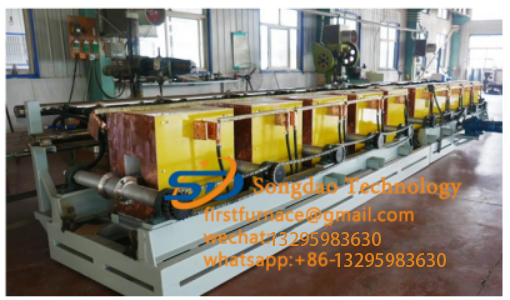- 07
- Jan
Aplicación del proceso de tratamiento térmico de enfriamiento de equipos de calentamiento de frecuencia intermedia
Aplicación del proceso de tratamiento térmico de enfriamiento de equipos de calentamiento de frecuencia intermedia
Basándose en su principio de calentamiento especial, el equipo de calentamiento de frecuencia intermedia realiza protección ambiental, ahorro de energía, alta eficiencia y otras producciones durante el proceso de procesamiento. En la actualidad, es muy popular entre los fabricantes de tratamientos térmicos en la industria de procesamiento mecánico.
Cuando el equipo de calefacción de frecuencia intermedia is used in the heating of metal quenching heat treatment, the carbon content of the workpiece of different materials mainly depends on the change of the carbon content. The distance between our matching induction coil and the workpiece should also be slightly adjusted. The simplest identification method is the quenching spark identification method when the intermediate frequency heating equipment is working. Check the sparks of the workpiece on the grinding wheel. You can roughly know whether the carbon content of the workpiece has changed. The higher the carbon content, the more sparks. .
Another scientific method of identification is to use a direct-reading spectrometer to identify the composition of steel. A modern direct-reading spectrometer can inspect and print out various elements and content of the workpiece material in a very short period of time to determine the steel. Whether it meets the drawing requirements. Excluding the carbon-poor or decarburization factors on the surface of the workpiece, cold drawn steel is more common. The surface of the material has a carbon-poor or decarburized layer. At this time, the surface hardness is low, but after 0.5mm is removed with a grinding wheel or a file, the hardness is measured. It is found that the hardness at this place is higher than that of the outer surface and meets the requirements, which indicates that there is a carbon-poor or decarburized layer on the surface of the workpiece.
Taking the workpiece spline shaft as an example, when we use intermediate frequency heating equipment for quenching, the reasons for the uneven hardness after quenching may be as follows:
1. Puede haber un problema con el material de la pieza de trabajo y el material puede contener muchas impurezas.
2. The process parameters are unreasonably determined during quenching.
3. Lo más probable es que la bobina de inducción esté hecha de manera irrazonable, lo que hace que la bobina de inducción esté a diferentes distancias de la pieza de trabajo, lo que da como resultado una temperatura de calentamiento desigual y una dureza desigual de la pieza de trabajo.
4. Check whether the cooling water circuit and the water outlet hole of the induction coil are smooth, otherwise it will cause uneven hardness.
When we apply intermediate frequency heating equipment to the quenching heat treatment process, we must also pay attention to a problem: the quenching heating temperature is not enough or the pre-cooling time is too long. If the quenching heating temperature is not enough or the pre-cooling time is too long, the temperature during quenching will be too low. Take medium carbon steel as an example. The quenched structure of the former contains a large amount of undissolved ferrite, and the structure of the latter is troostite or sorbite.
Además, cuando aplicamos equipos de calentamiento de frecuencia intermedia al proceso de tratamiento térmico de enfriamiento, la refrigeración insuficiente también es un gran problema. Especialmente durante el enfriamiento del escaneo, debido a que el área de pulverización es demasiado corta, después de que se enfría la pieza de trabajo, después de pasar por el área de pulverización, el calor del núcleo hace que la superficie se vuelva a templar automáticamente (el gran paso del eje escalonado es más probable que generarse cuando el gran escalón está en la posición superior), y la superficie es de retorno automático. La temperatura del fuego es demasiado alta, lo que a menudo se puede detectar por el color y la temperatura de la superficie. En el método de calentamiento de una sola vez, el tiempo de enfriamiento es demasiado corto, la temperatura de auto-templado es demasiado alta o el área de la sección transversal del orificio de rociado se reduce por la escala del orificio de rociado, lo que hace que el auto -Temperatura de templado demasiado alta. La temperatura del líquido de enfriamiento es demasiado alta, el caudal se reduce, la concentración cambia y el líquido de enfriamiento se mezcla con manchas de aceite. El bloqueo parcial del orificio de pulverización se caracteriza por una dureza local insuficiente, y el área de bloqueo blando a menudo corresponde a la posición de bloqueo del orificio de pulverización.

